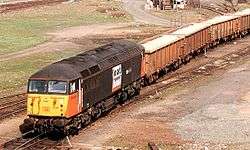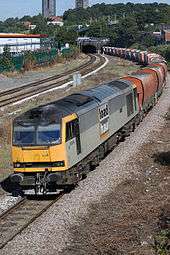Loadhaul
 | |
| Industry | Rail freight |
|---|---|
| Fate | Acquired by Wisconsin Central Ltd. |
| Successor | English Welsh & Scottish |
| Founded | 9 June 1994 as Trainload Freight North East |
| Defunct | 1996 |
| Headquarters | Doncaster, United Kingdom |
| Services | Freight train owner/operator |
| Parent | British Rail |
Loadhaul Ltd. was a railfreight operator based in the north-east of the United Kingdom. It was formed in 1994, as part of the privatisation of British Rail, and acquired in 1996 by a consortium headed by Wisconsin Central, then merged into a new company English Welsh & Scottish Railway.
History
Loadhaul was created in 1994, along with Transrail and Mainline as part of the broadly regional split of British Rail's Trainload Freight operations - Loadhaul's centre of operations were north east England, and south and east Yorkshire. The three companies were created with the aim of promoting competition between the businesses with the eventual aim of being privatised. It was initially and briefly named "Trainload Freight North East Limited" before being renamed Loadhaul Limited.[1][2]
All three former Trainload Freight companies including Loadhaul were acquired in February 1996 by 'North-South Railways': a company formed by a consortium led by US railroad company Wisconsin Central, for a combined total of £225.15million (approximately $349 million). The USA based Omnitrax in association with Loadhaul management submitted an unsuccessful bid under the name "FirstFreight". The three companies together with Rail Express Systems were formed into a new company, English Welsh & Scottish (EWS).[1][2][3][4]
Operations and traffic

In late 1995 the company employed 1,650, with a fleet of 194 locomotives and over 5000 wagons, carrying 38 million tons of freight with a revenue of $225 million (£144.9 million). The company's main locomotive depots were Immingham TMD, Blyth, Healey Mills, Thornaby TMD, Knottingley and at Doncaster Carr rail depot. Headed by Ian Braybrook who was previously a director for Trainload Freight, the company was split into two operational areas, North East and Yorkshire/Humberside. Each area had its own manager and administrative staff.
Coal formed just over half of the company's income, with much of the traffic originating from the Yorkshire collieries and in particular the Selby Coalfield. The Aire Valley power stations received much of the coal, with each power station taking up to 30 MGR trainloads every 24 hours. Coal was also transported in huge volumes to Scunthorpe Steelworks along with imported iron ore. Semi-finished steel products were forwarded from Scunthorpe to British Steel plants at locations such as Lackenby and Wolverhampton. Loadhaul also carried large volumes of petroleum traffic from the Lindsey and Humber oil refineries. Crude oil from the Lincolnshire Oil Field was also delivered to refineries on the Humber. Smaller but regular volumes of other traffics were also carried including paper for news print to Barking, construction blocks from the Plasmor Block plant at Heck near Selby and Salt & Potash from Boulby.[5]
Fleet
The total fleet including stored locomotives consisted of 66 Class 37s, 24 Class 47s and 57 Class 56 diesel locomotives, as well as 33 of the then new Class 60 diesel locomotives. The company also had 48 Class 08/09 shunting locomotives on its books.
An unusual member of the fleet was class 122 'Bubblecar' No. 55012. This was used primarily for driver training and retained Loadhaul livery well into the EWS era.
Loadhaul operated 2176 coal wagons, largely made up of HAA "MGR" and older HEA hoppers. 1250 wagons were operated on steel traffic, which included the bogie iron ore tippler wagons used on the Scunthorpe ore circuit. Closed vans and infrastructure vehicles contributed to over 1700 other wagons in the Loadhaul fleet.
Livery

The company was the first of the three trainload companies to introduce a completely new livery. Deliberately breaking with traditional railway colours of Yellow, Green, Red and Blue, Loadhaul introduced a livery of black with orange lower cabsides. Produced by Venture Design, the livery was also favoured for its practicality. Gloss Black bodysides helped disguise bodyside ripples and oil leaks; Orange lower cab sides helped to hide brake deposits. The logo and livery, with large blocks of colour running across the bodysides as opposed to typical "linear" and "streamline" designs, were designed with the brief to convey the message "Big & Heavy". This livery was unveiled at Doncaster Locomotive Works' open day on 9 June 1994, with 37713 and 56039 being the first locos to wear the livery.
It was the intention of the company to only repaint locomotives where existing paintwork was in poor condition. The paintwork on the Class 60 locomotives was still under warranty and most remained in triple grey livery and received a large body side logo and orange flashes next to the cab doors. However, June 1995 saw 60059 repainted in full Loadhaul livery and named "Swinden Dalesman". Unveiled at the Hillhead Quarry exhibition, the repaint was part of a public relations exercise with Tilcon Roadstone. No shunters received Loadhaul livery despite being operated by the company. A small fleet of lorries also received Loadhaul livery for carrying finished steel products.
Many wagons also received Loadhaul livery, with revenue earning stock such as HEA domestic coal hoppers and BDA steel flats being repainted during refurbishment. Non-revenue earning stock (engineering wagons) such as YGH Seacows and a shark brake van were also re-liveried.
References
- 1 2 C. Nash; T. Fowkes (2004), "Rail Privatisation in Britain - Lessons for the rail freight industry : 2. The privatisation process", in European Conference of Ministers of Transport. Economic Research Centre, Report of the Hundred and Twenty Fifth Round Table on Transport Economics Held in Paris on 28th-29th November 2002 on the Following Topic: European Integration of Rail Freight Transport, OECD Publishing, sections: C. Trainload, p.70; C1 EWS, pp.70-1
- 1 2 Philippe Thalmann (2004), The dynamics of freight transport development: a UK and Swiss comparison, Ashgate Publishing, The Privatisation of the Freight Business, p.34-35
- ↑ "Rail Privatisation". hansard.millbanksystems.com. Hansard, House of Commons, UK. 27 December 1996. volume 296, 275W.
- ↑ "WC group buys British freight services - Wisconsin Central buys Loadhaul, Transrail and Mainline Freight", Railway Age, Simmons-Boardman Publishing Corporation, March 1996
- ↑ Walker, Mike (September 1996). "Wisconsin Central's British Empire". Railfan & Railroad. 15. Carstens Publications. p. 44.
Sources
- WebCHeck - Select and Access Company Information, Companies House, see entries for LOADHAUL LIMITED, Company No. 02938985
- Paul Shannon "EWS - From Privatisation to DB" - 2012 Ian Allan Publishing ISBN 978-0-7110-3520-1
External links
| Wikimedia Commons has media related to Load-Haul. |